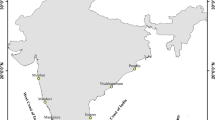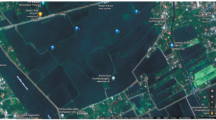Abstract
This present study was conducted to extend our understanding on the relationship between Chlorophyll a (Chl a) concentration and hydrological parameters typically flow velocity, environmental variables and trophic state conditions using lotic water as experimental system. River Mahanadi, India was selected as a model for the present study. Based on elevation from mean sea level, twelve sampling sites from Sambalpur to Naraj were grouped into three zones viz. upper zone (71 km), middle zone (142 km) and lower zone (103 km). Carlson Trophic State Index (CTSI) revealed eutrophic state in middle and lower zone and with mesotrophic condition in the upper zone. Along the river stretch, a negative correlation was observed between Chl a concentration and flow velocity at all three zones during post monsoon (r = − 0.15) and monsoon (r = − 0.31). Seasonal study revealed higher Chl a concentration (16.16–283.85 µg l−1) in post-monsoon with recorded mean flow velocity (0.28 ± 0.19 ms−1) as compared to monsoon season with lower Chl a (18.68–232.24 µg l−1) and mean flow velocity (0.54 ± 0.21 ms−1). Among environmental variables, water temperature and pH showed a positive correlation with Chl a. Overall, the findings of this study illustrated the occurrence of higher phytoplankton biomass (quantified as Chl a) during post-monsoon season coincides with low water velocity. The dataset of this work can be implicated for the hydrological and the ecological framework of the tropical river Mahanadi in the Indian Territory.





Similar content being viewed by others
References
American Public Health Association (APHA) (2012) Standard methods for the examination of water and wastewater, 22nd edition, APHA, AWWA and WEF, Springfield, New York
Bbalali S, Hoseini SA, Ghorban R, Kordi H (2013) Relationships between nutrients and Chlorophyll a concentration in the international Alma Gol Wetland, Iran. J Aquac Res Dev 4:173
Bowes MJ, Gozzard E, Johnson AC, Scarlett PM, Roberts C, Read DS, Armstrong LK, Harman SA, Wickham HD (2012) Spatial and temporal changes in chlorophyll-a concentrations in the River Thames basin, UK: are phosphorus concentrations beginning to limit phytoplankton biomass? Sci Total Environ 426:45–55
Boyer JN, Christopher RK, Peter BO, David TR (2009) Phytoplankton bloom status: chlorophyll a biomass as an indicator of water quality condition in the southern estuaries of Florida, USA. Ecol Indic 9S:S56–S67
Calijuri MC, Cunha DGF, Queiroz LA, Moccellin J, Miwa ACP (2008) Nutrients and chlorophyll-a concentrations in tropical rivers of Ribeira de Iguape Basin, SP, Brazil. Acta Limnol Br 20:131–138
Carlson RE (1977) A trophic state index for lakes. Limnol Oceanogr 22:361–369
Chaturvedi N, Meghal SA, Jasraj Y (2013) Is there impact of climate change on biological productivity in the Indian Ocean? Indian J Geo-Mar Sci 42:50–57
Chaurasia S, Gupta R (2016) Study on trophic state index of river Mandakini at Chitrakut, India. Int J Adv Res Eng Appl Sci 5:34–43
Chaurasia S, Karan R (2014) Assessment of water quality index and trophic state index of river Mandakini, India. Int J Plant Anim Environ Sci 4:343–347
Das Sarkar S, Naskar M, Gogoi P, Raman RK, Manna RK, Samanta S, Mohanty BP, Das BK (2019a) Impact assessment of barge trafficking on phytoplankton abundance and Chl a concentration, in River Ganga, India. Plos One 14:e0221451. https://doi.org/10.1371/journal.pone.0221451
Das Sarkar S, Gogoi P, Sarkar UK, Das Ghosh B, Mishal P (2019b) Trophic State Index to assess aquatic ecosystem health. Indian Farm 69:63–66
Desortová B, Puňcochář P (2011) Variability of phytoplankton biomass in a lowland river: response to climate conditions. Limnologica 41:160–166
Dey M, Chowdhury C, Pattnaik AA, Ganguly D, Mukhopadhyay SK, De TK, Jana TK (2012) Comparison of Monsoonal change of water quality parameters between 1983 and 2008 in a tropical estuary in Northeastern India: role of phytoplankton and community metabolism. Mar Ecol 34:14–29
El-Serehy HA, Abdallah HS, Al-Misned FA, Al-Farraj SA, Al-Rasheid KA (2018) Assessing water quality and classifying trophic status for scientifically based managing the water resources of the Lake Timsah, the lake with salinity stratification along the Suez Canal. Saudi J Biol Sci 25:1247–1256
Feipeng L, Zhang H, Zhu Y, Xiao Y, Chen L (2013) Effect of flow velocity on phytoplankton biomass and composition in a freshwater lake. Sci Total Environ 447:64–71
Fisher K (2013) Periphyton and phytoplankton chlorophyll a levels in the little bear river and Hyrum reservoir, Utah. Nat Resour Environ. Available at: http://digitalcommons.usu.edu/nrei/vol18/iss1/6
Gregor J, Marsalek B (2004) Freshwater phytoplankton quantification by chlorophyll a: a comparative study of in vitro, in vivo and in situ methods. Water Res 38:517–522
Ha K, Kim HW, Joo GJ (1998) The phytoplankton succession in the lower part of hypertrophic Nakdong River (Mulgum), South Korea. Hydrobiologia 369:217–227
Hilton J, O’Hare M, Bowes MJ, Jones JI (2006) How green is my river? A new paradigm of eutrophication in rivers. Sci Total Environ 365:66–83
Hondzo M, Lyn D (1999) Quantified small-scale turbulence inhibits the growth of a green alga. Freshw Biol 41:51–61
Huszar VL, Caraco NF, Roland F, Cole J (2006) Nutrient-chlorophyll relationships in tropical-subtropical lakes: do temperate models fit? Biogeochemistry 79:239–250
Istvánovics V, Honti M, Vörös L, Kozma Z (2010) Phytoplankton dynamics in relation to connectivity, flow dynamics and resource availability—the case of a large, lowland river, the Hungarian Tisza. Hydrobiologia 637:121–141
Jeong KS, Joo GJ, Kim HW, Ha K, Recknagel F (2001) Prediction and elucidation of phytoplankton dynamics in the Nakdong River (Korea) by means of a recurrent artificial neural network. Ecol Model 146:115–129
Jeong KS, Kim DK, Whigham P, Joo GJ (2003) Modelling Microcystisaeruginosa bloom dynamics in the Nakdong River by means of evolutionary computation and statistical approach. Ecol Model 161:67–78
Jeong KS, Kim DK, Shin HS, Kim HW, Cao H, Jang MH, Joo GJ (2010) Flow regulation for water quality (chlorophyll a) improvement. Int J Environ Res 4:713–724
Jeong KS, Kim DK, Shin HS, Yoon JD, Kim HW, Joo GJ (2011) Impact of summer rainfall on the seasonal water quality variation (Chlorophyll a) in the regulated Nakdong River. KSCE J Civ Eng 15:983–994
Ji Z-G (2017) Water quality and eutrophication. In: Hydrodynamics and water quality: modeling rivers, lakes, and estuaries, 2nd edition, Wiley, Amsterdam
Lehman PW (1992) Environmental factors associated with long-term changes in chlorophyll concentration in the Sacramento-San Joaquin delta and Suisun Bay, California. Estuaries 15:335–348
Leland HV (2003) The influence of water depth and flow regime on phytoplankton biomass and community structure in a shallow, lowland river. Hydrobiologia 506–509:247–255
Mohapatra BC, Sahoo SK, Das Gupta S, Gupta SD (2017) Biology of Mahanadi Mahseer, Tor mosalmahanadicus(David) Reared in Freshwater Pond Culture System. Curr Agric Res J 5:244–251
Naskar M, Das Sarkar S, Raman RK, Gogoi P, Sahu SK, Chandra G, Bhor M (2019) Quantifying plankto-environmental interactions in a tropical river Narmada, India. An alternative model-based approach. Ecohydrol Hydrobiol. https://doi.org/10.1016/j.ecohyd.2019.10.006
Nweze NO, Ude BO (2013) Algae and physico-chemical characteristics of Adani rice field, Enugu State, Nigeria. IOSR J Pharm Biol Sci 8:12–18
Palijan G (2012) Abundance and biomass responses of microbial food web component to hydrology and environmental gradients within a floodplain of the River Danube. Microb Ecol 64:39–53
Rocha RRA, Thomaz SM, Carvalho P, Gomes LC (2009) Modeling chlorophyll-a and dissolved oxygen concentration in tropical floodplain lakes (Paraná River, Brazil). Br J Biol 69:491–500
Rodrigues LA, Torres NH, Tornisielo VL, Ferreira LFR, Maranho LA (2015) Determination of toxicity assays, trophic state index, and physicochemical parameters on Piracicaba River and Itapeva Stream. Ambiente & Água Interdiscip J Appl Sci 10:310–317
Roger PA, Kulasooriya SA (1980) Blue-green algae and rice. The International Rice Research Institute, Laguna, p 112
Sabater S, Artigas J, Duran C, Pardos M, Romani AM, Tornes E, Ylla I (2008) Longitudinal development of chlorophyll and phytoplankton assemblages in a regulated large river (the Ebro River). Sci Total Environ 404:196–206
Salmaso N, Braioni MG (2008) Factors controlling the seasonal development and distribution of the phytoplankton community in the lowland course of a large river in Northern Italy (River Adige). Aquatic Ecol 42:533–545
SAS (2011) Statistical Analysis Software 9.3, 2 edn. SAS Institute Inc, Cary
Sobrino C, Neale PJ (2007) Short-term and long–term effects of temperature on photosynthesis in the diatom Thalassiosira pseudonana under UVR exposure. J Phycol 43:426–436
Strickland JDH, Parsons TR (1972) A practical hand book of seawater analysis. Bulletin 167:310 (Second Edition) Fisheries Research Board of Canada, Canadian Government Publishing Centre, Ottawa Canada
Thomaz SM, Pagioro TA, Bini LM, Roberto MC, Rocha RRA (2004) Limnology of the Upper Paraná Floodplain habitats: patterns of spatio-temporal variations and influence of the water levels. In: Thomaz SM, Agostinho AA, Hahn NS (eds) The upper Paraná River and its floodplain: physical aspects, ecology and conservation. Backhuys Publishers, Leiden, pp 76–102
United States Environmental Protection Agency (USEPA) (2002) Methods for evaluating wetland condition: using algae to assess environmental conditions in Wetland, Washington DC: Office of Water, U.S. Environmental Protection Agency, EPA-822-R-02-021
Upadhaya R, Pandey KA, Upadhaya SK (2013) Assessment of lake water quality by using Palmer and trophic state index- a case study of Upper Lake, Bhopal, India. Int Res J Environ Sci 25:1–8
Urrea-Clos G, García-Berthou E, Sabater S (2014) Factors explaining the patterns of benthic chlorophyll-a distribution in a large agricultural Iberian watershed (Guadiana river). Ecol Indicat 36:463–469
Van Nieuwenhuyse EE, Jones JR (1996) Phosphorus-chlorophyll relationship in temperate streams and its variation with stream catchment area. Can J Fish Aquat Sci 53:99–105
Acknowledgements
Authors are grateful to Indian Council of Agricultural Research, New Delhi for the financial support provided to carry out the research work under ICAR-CIFRI sub-project REF/ER/12/01/05 (Quantification of environmental flow in selected rivers for sustenance of ecology and fisheries). Technical assistance by Shri, A. K. Barui, former STO is thankfully acknowledged. Authors would also like to acknowledge efforts provided by District Fishery Officers, Department of Fisheries, Govt. of Odisha, all the Fishery officer with team members for their help and cooperation during sample collection. The authors are greatly indebted to Dr. Amit Kumar Sinha, Dept. of Aquaculture and Fisheries, University of Arkansas, Arkansas for his technical inputs to improve the manuscript.
Author information
Authors and Affiliations
Corresponding author
Electronic supplementary material
Below is the link to the electronic supplementary material.
Rights and permissions
About this article
Cite this article
Das Sarkar, S., Sahoo, A.K., Gogoi, P. et al. Phytoplankton biomass in relation to flow dynamics: the case of a tropical river Mahanadi, India. Trop Ecol 60, 485–494 (2019). https://doi.org/10.1007/s42965-019-00048-7
Received:
Revised:
Accepted:
Published:
Issue Date:
DOI: https://doi.org/10.1007/s42965-019-00048-7




